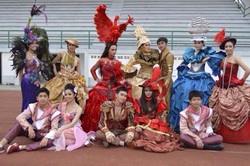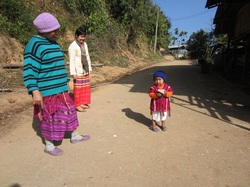 The costumes are astounding. That’s all there is to it. They are amazing, and they transform those who wear them into fantastic beings, quite above mere mortals. I admit I am impressed by the productions and fascinated by the cultural values that support them. I am delighted with the producer, too. Wi, whose real name is Chanon, grew up nearby. He went to school here and then decided to turn his creative flair into a career. For a few years he and his partner manufactured terra cotta garden figurines that sold well in Europe until the EU had an economic stumble. Wi and Nick then turned to costumes. Five years on, the “Showtime Collection Costume Shop” has a stock of hundreds for rent with scores more sold around the world. For a farmer’s son who was too poor to finish school, Wi is doing well. There is competition, of course, among costume shops but Wi has cornered the high-end market. At the age of 31 Wi is modestly wealthy. The key to his success is his talent for designing glamorous fantasy ensembles. He is hired to provide attire and make-up for amateur groups performing at fund-raising events, music contests, festivals, and at high school and college parties and celebrations. These days the budgets for groups run into five figures and the costumes are often custom-made by teams of seamstresses Wi directs. The question is “why?” The simple answer is that the events are fun. It is fun to step outside ordinary affairs and into the spotlight. In Thailand “fun” (sanuk) is a compelling motive for every successful undertaking including physical labor and even funerals. But there is a deeper level of satisfaction for the performers and their sponsors. What is the nearly universal drive of so many in this generation to acquire alternative characterizations? For some, these are occasional excursions into realms of fantasy. This aspect of Wi’s business is indicated by the word “showtime” in the name of his shop. The collection of costumes rival (or mimic) ideas from LasVegas and carnivals in Rio and New Orleans. They are creations of plumage and textiles attached to frameworks, exquisitely engineered. With the focus on the costumes, all that needs to be acquired by the performers is a degree of syncopation. For an easily distracted generation of young people this sort of temporary stardom is an agreeably short trip. Sponsors expect a return for their investment. This is not like a contribution for blankets for villagers in the mountains or for refurbishing a temple, where helpfulness, compassion and merit are the pay-offs. The sponsors expect credit. They and the performers want pictures. Whether the event is a sales campaign or a centennial celebration, the photo-record needs glamour. Post-modernism has deconstructed the big picture and serves it back as fragments in a random pattern. A connection is not implied. An attempt to reconstruct the “whole thing” is apt to be disappointing. The design needs care, but the content can be just about anything. In a photo-montage extra-close-ups and panoramas, garish colors and subdued hazy views coexist. There is nothing inconsistent about Wi’s costumed dancers sharing the stage at a sports-medal award night. In the overall school experience being splendid for a night nicely complements whatever the main event may have been, and these days all those diverse efforts demand to be considered valid.
0 Comments
 Graduations are surreal here in Thailand. On the whole, university commencements resemble a fair more than a solemn ceremony. There is a core event that is fraught with solemnity, highly enhanced if the one presenting the diplomas is a member of royalty, as is generally the case. Every facet and movement is choreographed and rehearsed to perfection. Despite the number of participants, being in the thousands, there is a tiny moment, often literally one second long, when every individual is face to face with a Prince or Princess of the Kingdom. That moment must be preserved photographically. There is no chance for a repeat, so, just to be sure, two expert photographers take prized pictures of the diploma passing from the royal hand into the hand of the graduate. That picture is displayed forever-after in the graduate’s home in a place where it can’t be missed. That is the moment that validates all the expense and effort of going to university. Commencement ceremonies to mark the culmination of successful educational undertakings are markers of real accomplishment by many stakeholders, including the graduate, the family, the faculty and the university. But there is something exaggerated about the celebration. For days, a graduate dons the cap and gown that will be worn at the ceremony and sallies forth with a team of photographers and a bevy of well-wishers to take pictures for an album. It seems that quantity is what counts. First, of course, are the iconic places on the university campus. There must be pictures of the graduate, standing, sitting, lying down or even posing grotesquely in front of every one of those. The larger the campus, the more pictures there will be of this type. But the world is the campus at large, so the photographic expedition then moves to signature sites around town, whether they have any particular relevance to the graduate or not. On the day before commencement there will be a final dress rehearsal. That will also be an occasion for group photographs. Two pictures, at least, are necessary: one of the whole graduating class and another of the graduates from each college or faculty. But that’s just the beginning. For hours, each graduate corrals as many teachers and groups of friends as happen to be within range. On commencement day the carnival atmosphere is in full swing. Whole families and sometimes truck-loads from afar converge on the commencement arena. Picnics are everywhere. Booths near every avenue to the grounds sell bouquets of flowers, leis, wreaths and corsages, but also balloons, dolls and stuffed animals. That is our main clue as to what this is all about, and what sets it apart from a commencement in Oxford or UCLA where the message the graduate wants to communicate is about completion, independence and setting forth. Thai commencements are about creating a fantasy. It is far more important than the silly frivolity it appears to be. A stuffed panda, a crown of daisies, and an armload of bouquets signify nothing about the meaning of the occasion except that “I am affirmed.” Each toy and blossom underscores that. Although there is no contest as such, one can take pride in the unwieldy volume of affirmations heaped on, and the stacks of photos recording evidence of at least as many momentary admirers. We might wonder why this affirmation is so aggressively asserted if there is no doubt about it. Might there be something in Thai psycho-social reality that denies the significance of a young individual? Until recently (in historical terms) there were few, if any, avenues of upward social mobility. One was what one was born to be. Education is an escalator. But there are forces still powerful to reduce the affect and to restrain those who try to rise too high. Current social and political unrest, I am convinced, can be viewed through this lens. Post-modernism is the philosophical equivalent of global warming. The frozen masses are thawing. This is an age of individualism in which every person is of ultimate significance, while collectively being insignificant. How significant is any single person to Mitsubishi world enterprises or Nestle S.A.? But the mega units of society and culture cannot contain and define the new generation. A graduate may be subjected to the mass market before the roses in the graduation bouquets drop their petals, but the pictures fade slower. They attest: “Let the evidence show there was one day when I was inundated with affirmation. That day I was outstanding.” Note: the picture accompanying this essay is from the Payap University website documenting commencement the last weekend of November 2013. For more pictures, access www.payap.ac.th  A Sagaw Karen boy up in the hills of Mae Hong Sorn Province, Thailand, on the border with Burma is carrying a Bible he cannot even begin to read, on his way to the first of three church services the Sunday after Christmas. Thanks to Dr. Prasit Pongudom for taking this picture and providing it. I was looking for a picture to commemorate Children’s Day (second Saturday of January) here in Thailand. The picture drew my attention not only because the kid is cute, but because of what it suggests about why the Karen Baptist Church is arguably the largest Church in South East Asia (aside from the Roman Catholic Church in the Philippines). In this era of secular erosion of all faith traditions, the Karen Baptist Church is stable and in its indigenous regions it is growing despite being in the vortex of nearly 50 years of war and internal displacement in Burma. In that boy’s village everyone carries their Bibles to church. The boy is doing what he sees everyone doing. Bibles aren’t left at the church as if there’s no need of them anywhere else. So he is taking his role as part of the community. There is no hint in that village that faith is separated from life. Faith and life are twisted and braided. Most significantly, Karen Baptist life is social. When a pig is killed everyone eats. When the church gong sounds, everyone gathers. Things are expected to happen because it is the right time for them. According to Baptist tradition “believers” are baptized, but the boy will be baptized with a whole bunch of others when the time is right. “When bananas are ripe the whole stalk is brought home.” Karen life is not one banana or one bean at a time. Theoretically, at some point they will have to explain to that little boy that confession of faith is an individual matter. The idea will not have occurred to him. Nor will it have occurred to him that there could be any doubt about faith. In fact, the concept of religious choice, doubt and agnosticism may never make much sense to him unless he is cast into the milieu of pluralism in the valley down below (as he may well be), where confusion about everything reigns until it has become the new normal. Down in the valley there are towns with big markets and bigger towns with shopping malls. Choice abounds. Hardly any of the boys down below have red shirts hand-woven by their mothers with the unique threads of their home village running down the front. Not everybody down below eats much the same thing because it is in season. Not everybody hears the gong calling them to assemble on a Sunday morning. Let me be clear: I am suggesting that social coherence is a key to understanding religious bonding. Societies that are fragmenting will have trouble holding onto their children. Religious communities cannot survive that. Religion itself is another matter. For the most part religions evolve and renew themselves. |
AuthorRev. Dr. Kenneth Dobson posts his weekly reflections on this blog. Archives
March 2024
Categories |
| Ken Dobson's Queer Ruminations from Thailand |
|
 RSS Feed
RSS Feed
